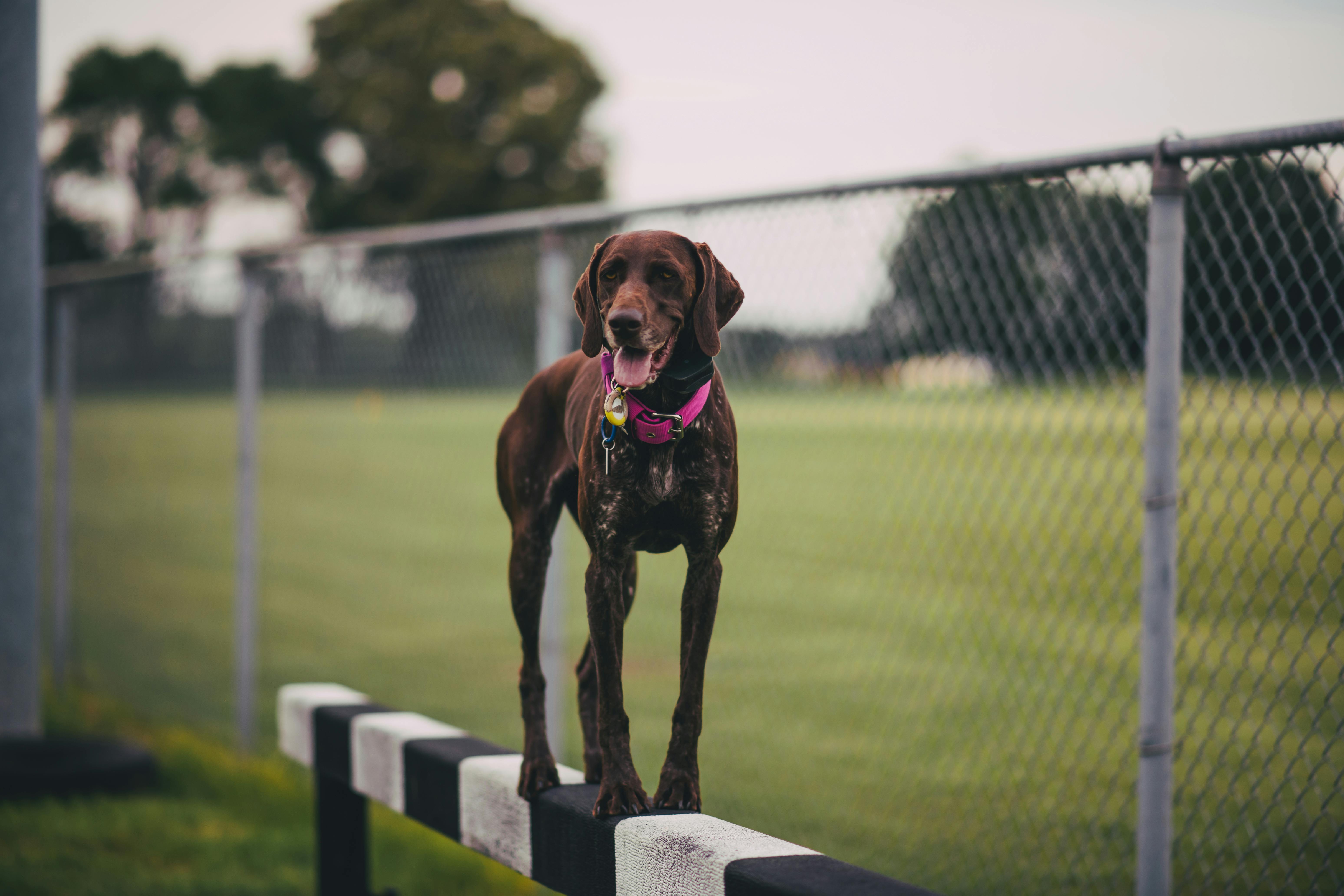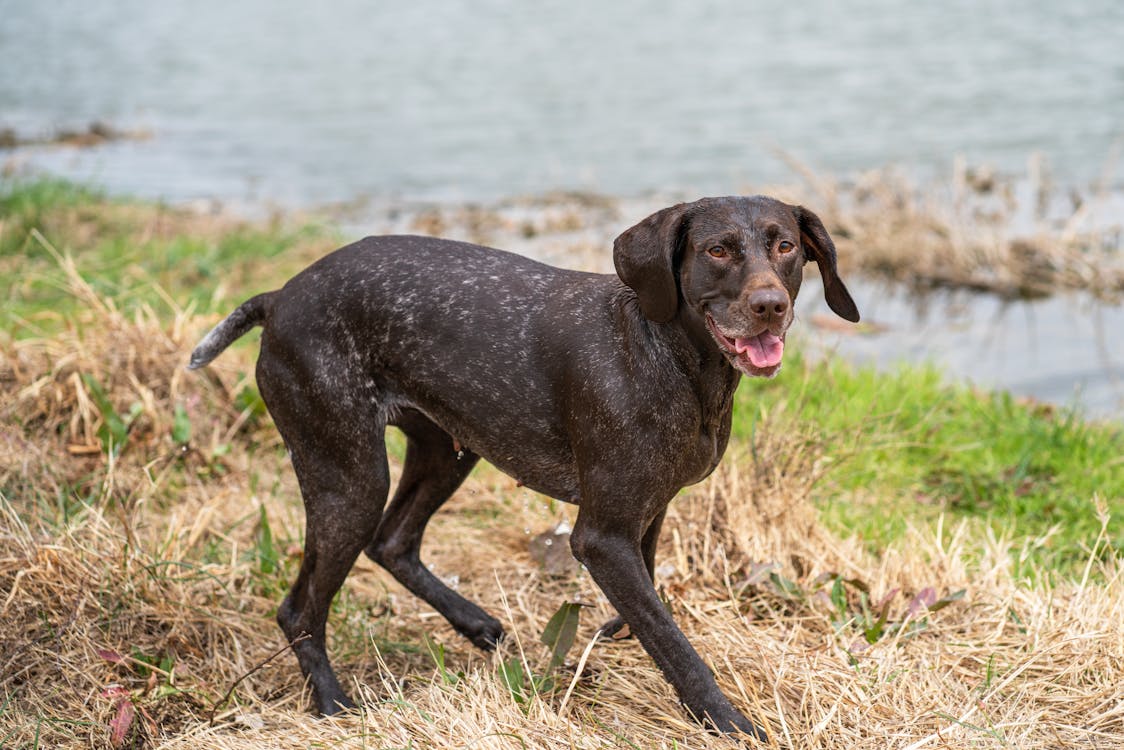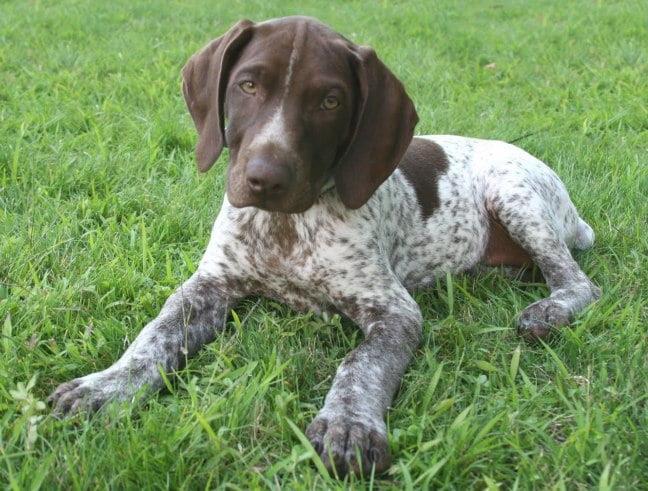Size: Medium to large, males 62-66cm at the shoulder and females 58-63cm
Weight: Males 25-32kg and females 20-27kg
Coat: Short, thick and water-resistant
Colour: Liver or liver and white, black or black and white, or solid liver
Temperament: Intelligent, energetic, friendly, and loyal
Life Span: 12-14 years
Health Issues: Hip dysplasia, ear infections, and bloat
Exercise Needs: High, at least 2 hours of vigorous exercise per day
Training: Easy to train, responds well to positive reinforcement
Grooming: Minimal grooming required, weekly brushing and occasional bathing
The German Shorthaired Pointer is a versatile and energetic breed, known for its intelligence and friendly nature. This article aims to provide a comprehensive look at the breed’s characteristics, history, and care needs. Whether you’re considering adding one to your family or just curious, you’ll find valuable insights here.
Brief Overview of the German Shorthaired Pointer
These dogs are medium to large in size, with a sleek, athletic build. Their short coat is easy to maintain, and they come in a variety of colours, often with distinctive spots or patches. Known for their boundless energy, they thrive in active households where they can get plenty of exercise.
History and Origin
The German Shorthaired Pointer has its roots in 19th-century Germany. Bred as a hunting dog, it was designed to be an all-purpose companion in the field. Combining traits from various breeds, including the Spanish Pointer and local German breeds, it became a favourite for its versatility and keen sense of smell.
Early Development of the Breed
The German Shorthaired Pointer was crafted with precision in the 19th century. Breeders aimed to create a dog that excelled in various hunting tasks. By blending the Spanish Pointer with local German breeds, they achieved a dog that was not only versatile but also reliable in the field. This breed quickly gained popularity for its adaptability and skill.
Role in Hunting and Sporting Activities
These dogs are natural athletes. Their keen sense of smell and strong work ethic make them exceptional hunting companions. Whether it’s tracking, pointing, or retrieving, they do it all with enthusiasm. Beyond hunting, they shine in various dog sports, showcasing their agility and intelligence.
Key Historical Figures Involved in the Breed’s Creation
Prince Albrecht of Solms-Braunfels played a pivotal role in the breed’s development. His vision was to create a versatile hunting dog, and his efforts laid the foundation for the German Shorthaired Pointer we know today.
Physical Characteristics
With a sleek, muscular build, these dogs are built for endurance. Their short coat is dense and water-resistant, perfect for all-weather activities. Typically, they have a striking appearance with a mix of liver and white colours, often adorned with spots or patches.
Appearance and Unique Physical Traits
The German Shorthaired Pointer stands out with its medium to large size and athletic build. Its sleek, muscular frame is designed for endurance and agility, making it a natural athlete. The coat is short and dense, often a mix of liver and white, with distinctive spots or patches that add to its striking appearance. This breed’s water-resistant coat is perfect for all-weather activities, whether it’s a day at the beach or a romp in the rain.
Temperament and Behaviour
Known for their friendly and intelligent nature, German Shorthaired Pointers are great companions for active families. They thrive on exercise and mental stimulation, so they’re happiest when they have a job to do. Whether it’s a game of fetch or a long hike, these dogs are always up for an adventure. They’re also known for their versatility, excelling in various dog sports and activities. With the right training and socialisation, they can be both loyal family pets and skilled working dogs.
Typical Personality Traits
German Shorthaired Pointers are known for their loyalty and intelligence. They form strong bonds with their families and are eager to please, making them quick learners. Their high energy levels mean they’re always ready for action, whether it’s a game of fetch or a long run. These dogs are curious and alert, always on the lookout for something interesting.
Suitability as a Family Pet and Working Dog
As family pets, they’re affectionate and protective, fitting well into active households. Their working dog heritage means they excel in roles that require stamina and focus. Whether it’s hunting, search and rescue, or agility sports, they’re up for the challenge.
Interaction with Children and Other Animals
German Shorthaired Pointers generally get along well with children, thanks to their playful and gentle nature. They can also coexist with other animals if properly socialised from a young age. Their friendly disposition makes them great companions for both kids and pets.
Training and Exercise Needs
These dogs thrive on training and need consistent mental and physical stimulation. Regular exercise is crucial to keep them happy and healthy. Activities like running, hiking, or participating in dog sports are ideal. Training should be positive and engaging, tapping into their intelligence and eagerness to learn.
Training, Exercise, and Health
Importance of Early Training and Socialisation
Getting your German Shorthaired Pointer started with training and socialisation early on is key. These dogs are smart and eager to learn, so introducing them to different environments, people, and other animals helps them grow into well-rounded adults. Early training sets the foundation for good behaviour and helps curb any unwanted habits before they start.
Recommended Training Techniques
Positive reinforcement is the way to go with these dogs. They respond well to praise, treats, and playtime as rewards. Keep training sessions short and fun to maintain their interest. Consistency is crucial, so make sure everyone in the household is on the same page with commands and rules.
Daily Exercise Requirements and Activities They Enjoy
German Shorthaired Pointers are high-energy dogs that need plenty of exercise. Aim for at least an hour of vigorous activity each day. They love running, hiking, and swimming, and they excel in dog sports like agility and flyball. Keeping them active not only satisfies their physical needs but also keeps their minds sharp.
Health and Lifespan
Generally healthy, these dogs have a lifespan of around 12 to 14 years. Regular vet check-ups, a balanced diet, and plenty of exercise contribute to their well-being. Be aware of potential health issues like hip dysplasia and ear infections, and keep an eye on their overall condition to ensure a long, happy life.
Common Health Issues
German Shorthaired Pointers are generally healthy, but like any breed, they can be prone to certain health issues. Hip dysplasia is a common concern, so regular vet check-ups are essential. Ear infections can also occur due to their floppy ears, so keep them clean and dry. Regular monitoring and early detection can help manage these issues effectively.
Average Lifespan and Health Tips
With proper care, these dogs typically live between 12 to 14 years. To keep them healthy, ensure they get plenty of exercise and a balanced diet. Regular vet visits and vaccinations are crucial. Mental stimulation is just as important as physical activity, so engage them with puzzles and training exercises.
Preventative Care Recommendations
Preventative care is key to a long, healthy life. Regular dental care, flea and tick prevention, and maintaining a healthy weight are all important. Consider joint supplements if recommended by your vet, especially as they age. Keeping up with vaccinations and parasite control will also help prevent common ailments.
Grooming and Maintenance
Their short coat is low-maintenance, requiring only occasional brushing to remove loose hair. Regular nail trimming and ear cleaning are important to prevent infections. Bathing should be done as needed, but not too frequently to avoid stripping natural oils from their coat. A simple grooming routine will keep them looking and feeling their best.

Coat Care and Grooming
Coat Care and Grooming Routines
The German Shorthaired Pointer’s short coat is a breeze to maintain. A quick brush once a week is usually enough to keep it looking sleek and healthy. This not only removes loose hair but also helps distribute natural oils, keeping the coat shiny. Regular grooming sessions are a great opportunity to check for any skin issues or parasites.
Shedding and Seasonal Grooming Tips
While they don’t shed excessively, you’ll notice an uptick during seasonal changes. During these times, increase brushing to a couple of times a week to manage the extra hair. A rubber grooming mitt can be particularly effective in removing loose fur and giving your dog a gentle massage.
Diet and Nutrition
A balanced diet is crucial for the health and vitality of your German Shorthaired Pointer. High-quality dog food, rich in protein and healthy fats, supports their active lifestyle. Consider their age, weight, and activity level when determining portion sizes. Fresh water should always be available, and treats should be given in moderation to maintain a healthy weight.
Nutritional Needs for Optimal Health
Feeding your German Shorthaired Pointer a balanced diet is key to their health and energy. Opt for high-quality dog food that’s rich in protein and healthy fats. This supports their active lifestyle and helps maintain muscle mass. Look for foods with real meat as the first ingredient and avoid fillers like corn and soy.
Foods to Include and Avoid
Include lean meats, fish, and vegetables in their diet. These provide essential nutrients and keep their coat shiny. Avoid foods with artificial preservatives, colours, and flavours. Chocolate, grapes, and onions are toxic to dogs, so keep these out of reach.
Feeding Schedules and Portion Recommendations
Feed adult German Shorthaired Pointers twice a day to maintain energy levels. Puppies may need three to four smaller meals daily. Adjust portions based on their age, weight, and activity level. Consult your vet for specific recommendations tailored to your dog’s needs.
Fun Facts and Trivia
Did you know German Shorthaired Pointers are excellent swimmers? Their webbed feet make them naturals in the water. They also have a unique ability to point, which is a trait bred into them for hunting. This breed is known for its versatility, excelling in various dog sports and activities.

Interesting Tidbits and Famous German Shorthaired Pointers
Interesting Tidbits about the Breed
German Shorthaired Pointers are not just skilled hunters; they’re also known for their unique ability to “point” at game. This instinctive behaviour is a result of generations of selective breeding. Their webbed feet make them excellent swimmers, a trait that comes in handy during waterfowl hunting. These dogs are also known for their incredible stamina, often able to run for miles without tiring, making them perfect companions for long-distance runners.
Famous German Shorthaired Pointers in Media or History
In the world of media, German Shorthaired Pointers have made their mark. One notable example is “Ranger,” a dog featured in the popular TV series “The Incredible Dr. Pol.” Ranger’s intelligence and charm captured the hearts of viewers, showcasing the breed’s versatility and friendly nature. Historically, these dogs have been favoured by hunters and outdoor enthusiasts for their reliability and skill, often appearing in hunting literature and art as the quintessential hunting companion.
Final Thoughts
The German Shorthaired Pointer is a remarkable blend of versatility and energy. This breed’s rich history and dynamic characteristics make it a standout choice for active families and dedicated hunters alike. With proper care, training, and socialization, these dogs offer boundless companionship and loyalty. Embrace the journey of owning a German Shorthaired Pointer, and you’ll find a devoted partner in both adventure and everyday life. Consider welcoming this exceptional breed into your home and experience the joy they bring.
German Shorthaired Pointer FAQs
German Shorthaired Pointers are not typically used as guard dogs. While they are loyal and protective of their family, they are generally friendly towards strangers.
Yes, German Shorthaired Pointers can be great with children. They are playful and enjoy spending time with their family. However, they can be boisterous and may accidentally knock over small children.
Yes, German Shorthaired Pointers are intelligent and eager to please, which makes them relatively easy to train. Early socialization and obedience training is recommended.
While German Shorthaired Pointers can adapt to apartment living, they require a lot of exercise and room to run. They are better suited to homes with a fenced-in yard.
While generally healthy, German Shorthaired Pointers can be prone to certain health issues such as hip dysplasia, ear infections, and bloat. Regular vet check-ups are important.
German Shorthaired Pointers need a lot of exercise. They are very energetic and require daily walks, runs, or playtime in a fenced-in yard.
German Shorthaired Pointers have a short, easy-to-maintain coat. Weekly brushing and occasional baths are usually sufficient.
The German Shorthaired Pointer breed was developed in Germany in the 19th century for hunting and pointing game.
The average lifespan of a German Shorthaired Pointer is 10-12 years. With proper care and exercise, they can live longer.
German Shorthaired Pointers are known for being friendly, intelligent, and energetic. They are loyal and make great family pets.
Related posts
Recent Posts
- Pet Emergency Preparedness: Ensuring Your Furry Friend’s Safety in a Crisis
- The Importance of Pet Vaccinations: Protecting Your Furry Friends
- Kitten Feeding Guide: Essential Tips for New Cat Owners
- Dangerous Pets: What You Need to Know Before Bringing One Home
- Understanding Pet Loss Grief: Coping with the Loss of a Beloved Animal Companion


